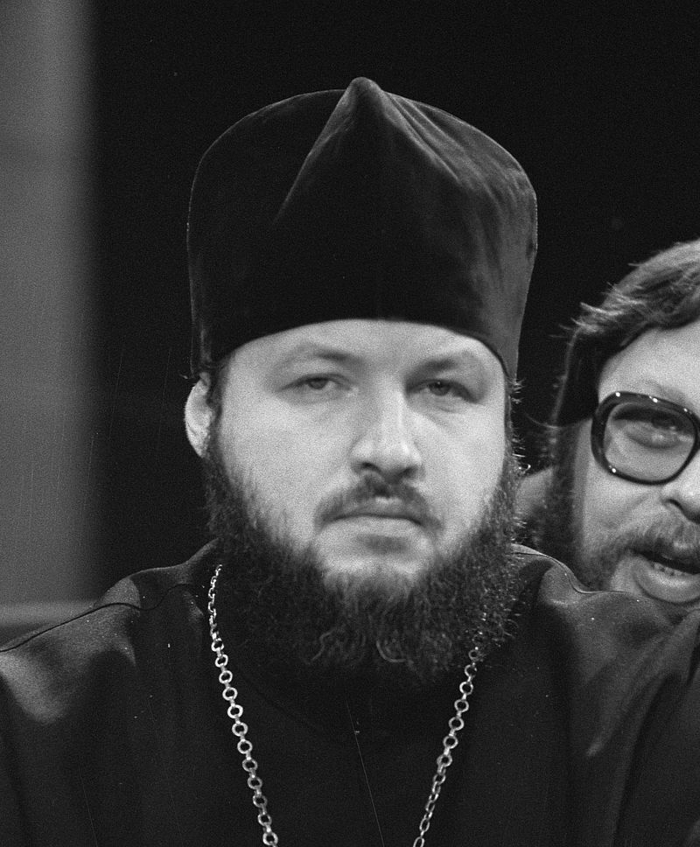
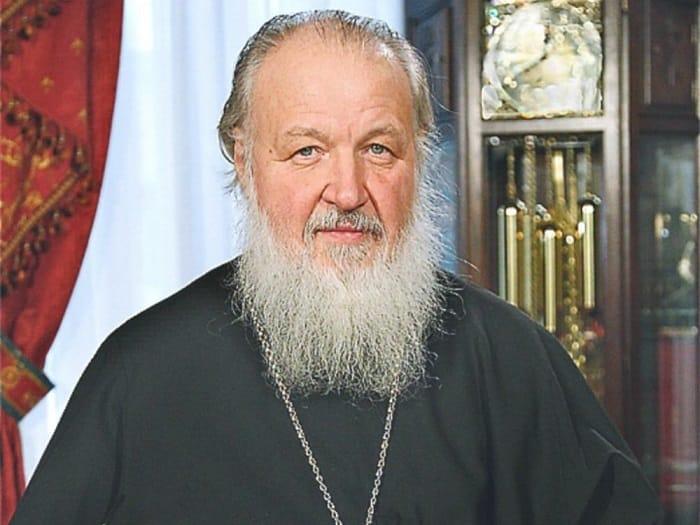
Two images of Russian Orthodox Patriarch Kirill, the top one taken in 1981 when he was about 35 (taken at a conference on nuclear weapons and disarmament in Amsterdam, Holland), the second one taken recently. Kirill has been the leader of the Russian Orthodox Church for 12 years, since February 1, 2009, when he succeeded the late Patriarch Alexi II. He is now 74. Yesterday, Kirill made some intriguing statements about what happened in the days after the Soviet Union fell (see below)
Letter #20, 2021, Tuesday, April 27: Kirill
From the heart of Russia
Today I write to send you a brief, but quite important, recollection published yesterday, April 26, in Russia.
The recollection is that of the Russian Orthodox Church’s Patriarch, Kirill, now 74.
It concerns critical moments at the time of the collapse of the Soviet Union in the early 1990s.
Kirill was then in his mid-40s (so, about 10 years older than he is in the photo at the opening of this letter, which was taken in 1981, when he was 35).
Kirill says that powerful men in Russia at that time offered the Orthodox Church leadership a role in leading post-Soviet Russia.
And he says the Church leaders refused the offer, recognizing that the Church must offer spiritual life to souls, not temporal peace and prosperity for their fleshly bodies — as important and filled with dignity as those bodies, those “temples of the Holy Spirit,” may be precisely because they are “in the image and likeness of God.”
So these recollections of Kirill seem important for all who are interested in Russia, and in the Russian people, and in the Christian faith in Russia, and in the role of Russia in history, both secular history and salvation history.
And perhaps one of you, my readers, might help me regarding a perplexity I have: why does Kirill recall these events publicly now, precisely now?
Kirill has been the leader of the Russian Orthodox Church since 2009.
Yet now is the first time he has ever spoken about these historic events.
What Kirill tells us is that, as the Soviet Union began to collapse — one may imagine a huge iceberg slipping slowly off of a coastal glacier, in Greenland perhaps, into the sea, with a mighty, colossal splash into the icy ocean waters, as what had seemed so durable suddenly slides and breaks apart into myriad fragments — a proposal was made by key players in Russia to the Russian Church.
And Kirill says the proposal was rejected.
One thinks of the temptations that the devil proposed to Jesus after Jesus had spent 40 days fasting and praying in the desert: that the devil would grant Jesus political power over all the earth, if Jesus would agree to bow down and offer worship to the devil.
Jesus rejected that temptation, saying that only God is worthy of worship and adoration.
Kirill says that the Russian Church leaders rejected that offer then, in the early 1990s, and I wonder if they did not have the same reason: only God is worthy of our worship and adoration, not any political party or system or any prince of this world, no matter how many benefactions such a prince may appear to bestow upon us.
So I wonder if Kirill perhaps speaks out now because he sees a similar danger in our time, and wishes to warn Christians everywhere not to yield to a similar temptation that looms. Would that be a possible correct interpretation of his remarks?
Here are Patriarch Kirill’s recollections (link):
26 April 2021, 11:50
Patriarch Kirill speaks of offer to head up opposition in 1990s
Moscow, April 26, Interfax — Patriarch Kirill of Moscow and All Russia said he had received an offer to head up the opposition in the early 1990s.
“Older people remember that there was a real civil conflict over the White House. [Note: The residence of the Russian president.]
“Multidirectional political will of various political forces was concentrated there.
“I was then a permanent member of the Holy Synod and chairman of the Department for External Church Relations, who was in charge of interaction, including with the government and public organizations.
“Knowing about that, a delegation of deputies came to me, asking me to lead the struggle against the hated regime or the attempts of the hated leader, I will not say that name, you know it well.
“And [they wanted] the Church to lead that struggle,” Patriarch Kirill said on Pussy-Willow Sunday [Palm Sunday, April 25 this year in the Orthodox calendar] after a liturgy in the Cathedral of Christ the Savior in Moscow.
The patriarch said he had just been told he had to go into the White House, take power and give it to the deputies.
“And we will all support you, and you, not me personally, but the Church, you will go down in history as the savior of Russia, that will lead to a sharp increase in religiousness, you will get new Church members if you head up the political struggle now,” the deputies said to the Church leader, according to Patriarch Kirill.
“I did not find any words except to say that the entire experience of the Church, Universal and Russian, shows that if the Church gets political power it becomes part of political struggle, it immediately gets political opponents, and there may be Orthodox Christians among political opponents.
“It means the Church, fighting for power or receiving power, inevitably breeds an opposition, including one that may include Orthodox Christians. The Church becomes a factor of people’s division,” Patriarch Kirill said.
Patriarch Kirill said he had asked himself the question as to whether the Church could be an authority, the house and spiritual mother to everyone if it identified itself with a specific political force and became a factor of political struggle.
“Never! Because a person who comes up to a church could [then] ask whether the people here are my political friends or my political foes.
“And today no one can ask themselves this question when they come to the doors of an Orthodox church, they are open to everyone, to all our people,” the patriarch said.
[End, Kirill’s recollection]
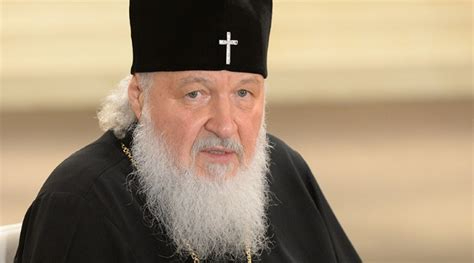
The Unitas Project
We have met on several occasions with Patriarch Kirill.
He has encouraged us to believe that Roman Catholics and Russian Orthodox may work together on common projects while we wait patiently for the slow work of theological dialogue to address disputed questions to take its course.
This has provided a foundation for our newest work, a work which we are about to launch worldwide: Unitas: “Come, Rebuild My Church.”
We are looking for 24 “Elders” and 153 “Founding Members” (we already have 60 of these Founding Members) to become the principal sponsors of this work, which will use every means to restore unity within the Catholic Church and to recover unity between the Catholic and Orthodox Churches. We would particularly like to include some members of the Orthodox faith.
With your support and encouragement, we will continue the work we have begun, seeking to bring Mary back to Russia, and to bring the “lux ex oriente” (“the light from the East”) back to the increasingly materialistic West.
Unitas: “Come, Rebuild My Church” will carry out initiatives to build unity — within the Catholic Church, and between the Catholic and Orthodox Churches, and in doing so between each of our souls and God one stone at a time… one living stone at a time… in the hope of the promise…
Here below is an entry in Wikipedia about the Icon of Our Lady of Kazan.
Many points are still obscure, and it may be that some points made in this Wikipedia report are not true.
However, after reading the report, I found it useful, though I cannot vouch for the truth of every statement made in it. —RM
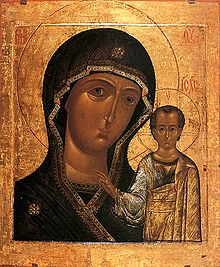
Our Lady of Kazan
(From Wikipedia, the free encyclopedia, link)
Our Lady of Kazan, also called Mother-of-God of Kazan (Russian: Казанская Богоматерь tr. Kazanskaya Bogomater), was a holy icon of the highest stature within the Russian Orthodox Church, representing the Virgin Mary as the protector and patroness of the city of Kazan, and a palladium of all of Russia, known as the Holy Protectress of Russia.
According to legend, the icon was originally acquired from Constantinople, lost in 1438, and miraculously recovered in pristine state over 140 years later in 1579. Two major cathedrals, the Kazan Cathedral, Moscow, and the Kazan Cathedral, St. Petersburg, are consecrated to Our Lady of Kazan, and they display copies of the icon, as do numerous churches throughout the land. The original icon in Kazan was stolen, and likely destroyed, in 1904.
The “Fátima image” is a 16th-century copy of the icon, or possibly the 16th-century original, stolen from St. Petersburg in 1917 and purchased by F. A. Mitchell-Hedges in 1953. It was housed in Fátima, Portugal from 1970 to 1993, then in the study of Pope John Paul II in the Vatican from 1993 to 2004, when it was returned to Kazan, where it is now kept in the Kazan Monastery of the Theotokos. Copies of the image are also venerated in the Catholic Church.
Feast days of Our Lady of Kazan are 21 July, and 4 November (which is also the Russian Day of National Unity).
History
According to tradition, the original icon of Our Lady of Kazan was brought to Russia from Constantinople in the 13th century. After the establishment of the Khanate of Kazan (c. 1438) the icon disappeared from the historical record for more than a century.
Metropolitan Hermogenes’ chronicle, written at the request of Tsar Feodor in 1595, describes the recovery of the icon. According to this account, after a fire destroyed Kazan in 1579, the Virgin appeared to a 10-year-old girl, Matrona, revealing the location where the icon lay hidden. The girl told the archbishop about the dream but she was not taken seriously. However, on 8 July 1579, after two repetitions of the dream, the girl and her mother recovered the icon on their own, buried under a destroyed house where it had been hidden to save it from the Tatars.
Other churches were built in honor of the revelation of the Virgin of Kazan, and copies of the image were displayed at the Kazan Cathedral of Moscow (constructed in the early 17th century), at Yaroslavl, and at St. Petersburg.
Russian military commanders Dmitry Pozharsky (17th century) and Mikhail Kutuzov (19th century) credited invocation of the Virgin Mary through the icon with helping the country to repel the Polish invasion of 1612, the Swedish invasion of 1709, and Napoleon’s invasion of 1812. The Kazan icon achieved immense popularity, and there were nine or ten separate miracle-attributed copies of the icon around Russia.
On the night of June 29, 1904, the icon was stolen from the Kazan Convent of the Theotokos in Kazan where it had been kept for centuries (the building was later blown up by the communist authorities). Thieves apparently coveted the icon’s gold frame, which was ornamented with many valuable jewels. Several years later, Russian police apprehended the thieves and recovered the frame. The thieves originally declared that the icon itself had been cut to pieces and burnt, although one of them eventually confessed that it was housed in a monastery in the wilds of Siberia. This one, however, was believed to be a fake, and the Russian police refused to investigate, using the logic that it would be very unlucky to venerate a fake icon as though it were authentic. The Orthodox Church interpreted the disappearance of the icon as a sign of tragedies that would plague Russia after the image of the Holy Protectress of Russia had been lost. Indeed, the Russian peasantry was wont to credit all the miseries of the Revolution of 1905, as well as Russia’s defeat in the Russo-Japanese War of 1904–1905, to the desecration of her image.
After the Russian Revolution of 1917, there was speculation that the original icon was in fact preserved in St. Petersburg. Reportedly, an icon of Our Lady of Kazan was used in processions around Leningrad fortifications during the Siege of Leningrad (1941-1944) during World War II.[4]
Another theory proposed that the Bolsheviks had sold the image abroad, although the Russian Orthodox Church did not accept such theories. The history of the stolen icon between 1917 and 1953 is unknown. In 1953 Frederick Mitchell-Hedges purchased an icon from Arthur Hillman. Although the status of the icon as the original Kazan icon remained disputed, Cyril G.E. Bunt concluded “that it is the work of a great icon painter of the 16th century […] the pigments and the wood of the panel are perfectly preserved as exhaustive X-ray tests have proved, and have mellowed with age”, suggesting that while it was a copy of the original icon, it was nevertheless the original icon carried by Pozharski in 1612. It was exhibited at the World Trade Fair in New York in 1964–1965. On 13 September 1965, members of the Blue Army of Our Lady of Fátima spent the night in veneration of the icon in the pavilion in New York. The Blue Army eventually bought the icon from Anna Mitchell-Hedges for US$125,000 in January 1970, and the icon was enshrined in Fátima, Portugal.
In 1993 the icon from Fátima was given to the Vatican and Pope John Paul II had it installed in his study, where he venerated it for eleven years. In his own words, “it has found a home with me and has accompanied my daily service to the Church with its motherly gaze”. John Paul II wished to visit Moscow or Kazan so that he himself could return the icon to the Russian Orthodox Church. However the Moscow Patriarchate was suspicious that the Pope might have other motives, so he presented the icon to the Russian Church unconditionally in August 2004. On August 26, 2004, it was exhibited for veneration on the altar of St. Peter’s Basilica and then delivered to Moscow. On the next feast day of the holy icon, July 21, 2005, Patriarch Alexius II and Mintimer Shaymiev, the president of Tatarstan, received it in the Annunciation Cathedral of the Kazan Kremlin.
The icon is now enshrined in the Cathedral of the Elevation of the Holy Cross, part of the Convent of the Theotokos (re-established as a monastery in 2005), on the site where the original icon of Our Lady of Kazan was found, and plans are underway to make the monastery’s other buildings into an international pilgrimage centre.
[End, Wikipedia article]

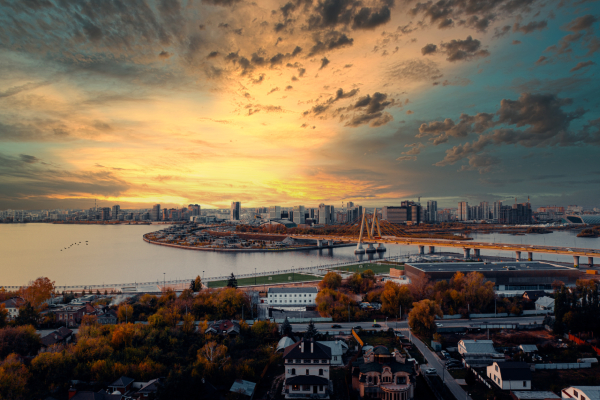




Facebook Comments